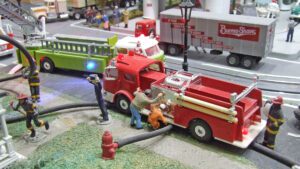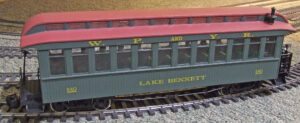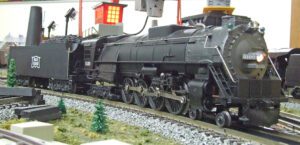Reminiscences of a Public Layout Operator
By Bill Fuller, TCA 87-26705 Winter 2023 e*Train
Sure, we all agree that running trains is fun. Some of us even think that building a layout is the ultimate pleasure and live for the hour that we can spend ballasting track with scale granite chips in a teaspoon and an eyedropper of dilute white glue. However, nothing beats the astonishment that accompanies running trains for the public at a club layout on open house day. Interactions with visitors can be memorable indeed. The snippets of memory that follow date from the 1980s when the Alaska Lionel Collectors Club was given the use of an unoccupied storefront in an Eagle River shopping center in which to build a layout for the entertainment of shoppers.

Now on another layout and at a different fire, the red pumper failed to impress a lady worried that smoke was drifting from windows of a model apartment building.
One day, a fellow club member and I had barely opened the doors when a very pleasant lady entered and spent some time carefully studying the burning apartment house residing maybe three feet in from the edge of the layout. Back in the days before we learned about Seuthe smoke generators, we had created our “fire” by drilling a hole through the layout table underneath the Plasticville apartment house, wedged an upside-down funnel into the bottom of the hole under the table and placed an incense burner below the funnel. We had great-smelling smoke coming from that structure! We also had a fire truck model equipped with flashing LEDs parked in front of the apartment house and model firefighters carrying a ladder toward it. Our lady visitor, however, had apparently fixated on only the smoke and, after a few moments’ hesitation, approached us with a worried expression on her face, saying, “There’s smoke coming out of one of your buildings.”
In perfect deadpan, my fellow operator asked, “Is the fire department there yet?” With that, the lady’s expression changed from concern to utter confusion, and she hurried back to the layout either to take another look at the scene or perhaps to put some distance between her and the decidedly strange fellow in the control booth. At any rate, this time she took in the fire truck and the firefighters rushing a ladder to the building. The confusion vanished from her expression, to be replaced by a delighted (and perchance slightly embarrassed) grin as she called back, “Yes, they’re on the scene.”
A small footnote to our burning apartment house creation is in order. The odor of our incense-created smoke led to more than one visitor casually mentioning marijuana. Perhaps they were hoping that we were selling it literally “under the table”?
On another occasion, we were politely but pointedly corrected by a visitor who noticed a real faux pas. One of our trains was made up as an intermodal behind a couple of Alaska Railroad Geeps. We had realistically oriented all of the TOFCs (trailers on flat cars) in the same direction. However, we unwittingly displayed our ignorance of prototype operations between Anchorage and Fairbanks by orienting them all backwards from how the “real things” ran. Our visitor that time happened to be an ARR employee, who told us that, were he to transport any TOFCs oriented as ours were, unloading the trailers in Fairbanks would be impossible given the facility at that location. We thanked him for the information and continued to operate our “unloadable” train, at least until there was a break in visitors, at which time we hurriedly reoriented all of our flat cars!
Over a rather extended period of time encompassing several weekend operations, we noticed an elderly, white-haired lady returning time and again to watch the layout action. She usually came into the room, watched for a leisurely length of time, and silently left. Finally, however, she must have decided that we operators didn’t appear to be too busy to talk a little and approached us. What she said has stayed with us for many years. “When I was a little girl, I always wanted an electric train, but I never got one. When Christmas came around, the trains all went to my brothers. All I ever got was a bunch of stupid dolls.” There may be a lesson here: Don’t overlook electric trains when helping Santa choose gifts for daughters!

WP & YR rebuilt
Then there was the time that we decided to put on an extra special display for the visiting public. In addition to our semi-permanent O gauge layout, we set up a couple of temporary tables spaced a couple of feet apart and connected by bridges. On these we ran a Bachmann G gauge White Pass & Yukon passenger train. Pretty soon, a mom came in with her energetic son, maybe around five or six years old. The lad was fascinated by the trains, the mom not so much as she sat near the far wall of the room wishing that she could get on with her shopping chores. Things got exciting when her lad’s exuberance, coupled with his mom’s inattention, culminated in his reaching an inquisitive hand to touch one of the WP&Y passenger coaches as it passed over a bridge. That coach hit the tile floor and exploded, the roof going one way and the wheels another. At that, the mom came to life, covering the distance from her chair to her son in microseconds, grabbing the luckless lad by the hand, and running—flying, actually—down the corridor leading from the layout room and vanishing into the parking lot. We assumed that she had visions of being handed a hefty invoice for the damage her son had caused. In actuality, we popped all the pieces of the car back together, returned it to the track, and went on with the show. Reassembled, WP&Y coach suffered no damage from its fall at the hands of an eager youngster. While the car was none the worse for wear, we doubt that the son escaped so unscathed, and model railroading probably lost a potential hobbyist that day.

Cleansed of her cola bath, Rock Island Northern #5100 plies the rails in her original hues.
The plummeting Bachmann coach does help explain why we had installed a clear Plexiglas shield around the O gauge layout. That 18” high barrier undoubtedly prevented countless derailments, but one day it failed miserably. A father had come in with his beautiful little girl, but she was as yet a little too short to see very far into the layout, and all of our short stools were occupied by other youngsters. To afford her a better vantage point, her dad hoisted her onto his shoulders, a loving and considerate act that would certainly have caused no problem—had the young lady not been holding a can of cola at the time. As it was, she leaned forward to better see a 4-8-4 Rock Island Northern leading a mixed freight below her. Whether we used WD-40 or Goo Gone we no longer remember, but whatever it was, it worked very well to remove dried cola from the locomotive’s diecast boiler.
Being aware of the importance of visitor interaction with trains, we decided to install some push buttons along the fascia so that folks could control several items on the layout: crossing gates, flashing signals and such like. By so doing, we learned a very important lesson for maintaining operator sanity: Connecting a push button to a Lionel diesel horn shed was perhaps not the best idea we had ever come up with. That thing exerted an attraction for young boys far beyond anything we had anticipated, and the associated push button not-so-mysteriously vanished before the next public show. True, we all associate the noise of Post-War-design toy trains with their operation, and we know the noise emanating from Lionel’s “Vibrator Motors” in the aquarium car, animated gondola, operating sawmill, operating horse car and corral, etc. is, shall we say, quite noticeable, but a weekend of never-ceasing blasts from the diesel horn shed may just violate the Geneva Conventions.
As we discovered one day, opening a club layout to the public sometimes has benefits that don’t even involve the trains. One Saturday, an operator’s spouse had accompanied him to the layout and was sitting back from the tables working on a knitting project. A mom and her daughter came in and approached her. Upon learning that what she was doing was, indeed, knitting, the lady said that her daughter really wanted to learn to knit but that she herself had no idea how it was done. Would our nice lady be willing to show her daughter, and what would be needed? Armed with a short list of essential materials, the lady scurried off to a shop in the mall where our layout was situated and shortly returned with needles and yarn, and her daughter got her introduction to the art of knitting. She may not have become a model railroader, but she left that day with the confidence to explore another new hobby.
On another occasion, our club was a real “light in the darkness” for numerous folks. We had been invited by an HO scale club on a nearby Air Force base to join them in an open house. We set up a couple of tables in the corridor outside their layout room and arranged a small temporary display to show our O scale models in operation. Electricity being a bit distant from our location, we powered only our transformers and used battery power for our scale houses and street lights. Now, the building in which the HO club had its layout was known for being somewhat finicky where current draw was concerned, and the club room was in a windowless basement. When the inevitable happened and the circuit breakers (at the far end of the long building) tripped, the basement was drowned in the blackest darkness imaginable, all except for our battery-powered layout lights! Providing illumination to wandering, lost souls is such a good feeling.
Collecting models, running trains, constructing layouts, creating scale scenery, even (at least for some of us) wiring everything can be enjoyable, comforting diversions from the cares and concerns of the workaday world. Nothing, however, quite measures up to the astounding experiences one encounters when interacting with visitors at a club layout opened to the public.





